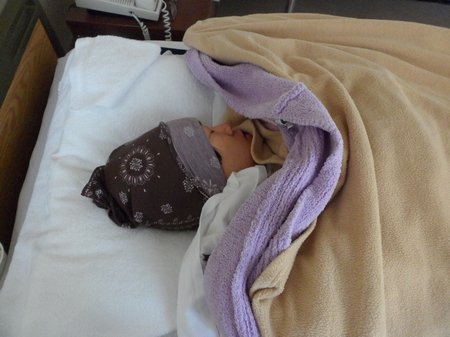Coley's Toxins IV #12 - 104 Fahrenheit
 Today, we decided to be a little daring and upped the dosage from 0.006ml -> 0.009ml (a factor of 50%). We decided to do this based on her response from fever #11 where we increased from 0.004->0.006ml. That 50% increase resulted in a clearly better fever, but still not quite high enough.
Today, we decided to be a little daring and upped the dosage from 0.006ml -> 0.009ml (a factor of 50%). We decided to do this based on her response from fever #11 where we increased from 0.004->0.006ml. That 50% increase resulted in a clearly better fever, but still not quite high enough.
We got the go ahead from the doctors here. The fever was a little slow to start. Normally, the stronger fevers seemed to manifest chills 1 hour after infusion start. This one was later at almost 2 hours.
The historical records really are true - that robust fevers are clearly associated with more intense chills. Today's chills didn't last that long -- only about 30 minutes. However, it was clear that they were more intense compared to previous ones. Similarly, fever#2 resulted in intense chills as well. Today's chills were continuous and occurred in many places - in her shoulders, arms, legs -- and a new location -- behind her head! I suppose the pillow under her head prevented the heating pad from warming up that area. Nonetheless, it was interesting to that this is the first time chills have occurred there.
Once the chills subsided, her temperature began to rapidly rise. It reached 103.4F about 15 minutes after the chills subsided. Shortly thereafter, it peaked at 104F. This is the first time it's hit that high.
(Picture: Fatigued and bundled up with 5 blankets + heating pads during the chill phase).

Interestingly, her fever didn't sustain at high levels for long. As in fever#11, it began to drop quite soon after peaking. Nevertheless, it was still a good, robust fever, reaching the highest peak ever.
Other observations:
- The past 2 fevers have not resulted in much aching in her long bones and hips. This occurred quite noticeably in earlier fevers. If those aches were indicative of bone marrow growth, it would be interesting to see how her WBC counts this Saturday are.
- As before, she began coughing 30 mins after infusion of Coley's started. This time, the coughing was more frequent. Not more intense, just more frequent. Her temperature was normal at that time, but her face looked a little flush/red. Later on, during the post-chills phase when her temperature began to rise, I noticed that her cough also became quite frequent. Subsequently, it diminished as her fever decreased.
Note:
- We just spoke with another patient here at the Issels ward. She received Coley's subcutaneously into her arm. She developed a fever of 104F (40C) for 5 hours! Boy, was that a major fever! After the fever broke, she had profuse sweating. The interesting point is that other Issels patients have also reported very long lasting fevers, 8 hours or more in some cases, that had to be stopped with Tylenol. That may be an advantage of subcutaneous administration (the downside being pain at injection site along with possibly unreliable development of fevers due to variable amount of Toxins entering the bloodstream?).
(Picture: Special Mexican Lunch at Oasis of Hope Hospital. Unfortunately, she missed this lunch -- she can't eat lunch on the days that she gets Coleys. This is because the stomach has to be empty to avoid nausea.)




